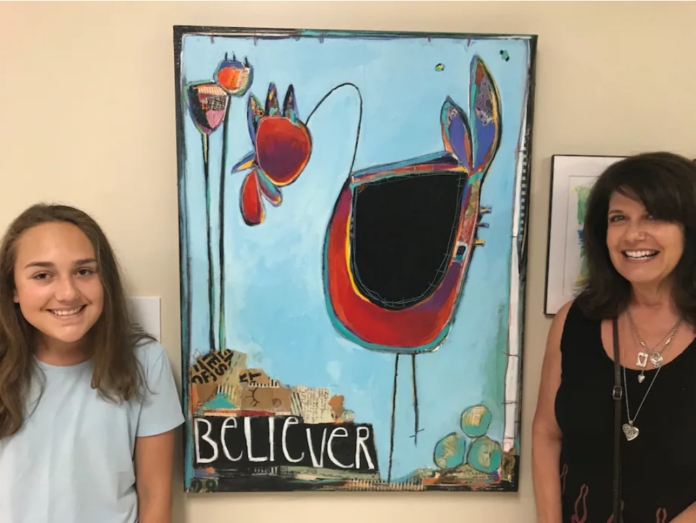Published in The Washington Post
August 14, 2019
The work, “Of Chickens & Fireflies” by Terry Sitz, is one of eight pieces in “Being Heard,” a new exhibition of empathetic art at the Children’s National Medical Center. On view through Sept. 27, the exhibition explores the role of art in creating a more compassionate, healing environment for children suffering from chronic illness.
Each of the paintings reflects the medical journey of a sick child by creating a visual impression of his or her struggle, expressed in poems and discussions with professionals who turned those experiences into artworks.
“It’s more typical to do the exterior, of what someone looks like,” Sitz, of Silver Spring, said about working with subjects on such intensely personal pieces. “This is an excavation of what is inside. I’m trying to channel someone else’s emotions. It’s an unmasking of their experience.”
Artists and arts organizations are increasingly exploring the intersection of art and health. Researchers are studying the benefits of music, art and dance therapies on medical conditions including opioid addiction, PTSD, anxiety and depression. The National Endowment for the Arts has boosted the reach of Creative Forces, its arts therapy program for veterans, and the Kennedy Center has partnered with the National Institutes of Health to study the way music affects the brain. “Being Heard” falls into the segment of research that focuses on how the design and artwork featured in medical settings can improve the environment and aid patient recovery.
The results of the small-scale study are encouraging, according to creator Judy Rollins, a registered nurse and scholar at the Institute for Integrative Health in Baltimore, which funded the project.
“We can say this experience allowed the children to be heard,” Rollins said about her findings. “They knew they had been heard and as they looked at the paintings they recognized themselves in them and that helped them to have a greater sense of well-being.”
One of the patients, a 17-year-old with ulcerative colitis, described the healing power of the project. “It makes me feel happier. Looking at it takes a weight off my shoulders,” she said after seeing “Sky Lilies,” by Lori Anne Boocks, for the first time. A 10-year-old boy with liver and kidney disease told Rollins the work by Sitz made him “feel excited and happy.”
“We can say this experience allowed the children to be heard,” Rollins said about her findings. “They knew they had been heard and as they looked at the paintings they recognized themselves in them and that helped them to have a greater sense of well-being.”
One of the patients, a 17-year-old with ulcerative colitis, described the healing power of the project. “It makes me feel happier. Looking at it takes a weight off my shoulders,” she said after seeing “Sky Lilies,” by Lori Anne Boocks, for the first time. A 10-year-old boy with liver and kidney disease told Rollins the work by Sitz made him “feel excited and happy.”
“Being Heard” began in 2017, when Rollins selected eight patients between ages 10 and 19 with serious chronic medical conditions and commissioned Maryland artists Boocks and Sitz to each create four paintings. Each patient wrote a poem that completed the statement, “I am from …” to give the artists a starting point for their interviews and art. After Boocks and Sitz conducted interviews with the patients, they returned to their studios to paint.
Jazz improv will change your brain
Boocks has long been interested in the connection between art and healing, but she said she had never worked on a commission like this. “The challenge here is to feel something from someone else, to channel it,” the Germantown resident said. “It’s about letting go of the artist ego and allowing the subject to be co-creator with you.”
Boocks’s paintings are abstract. One, titled “Shimmer Beach Dawn (What You See),” uses vivid yellow, red and black to create dramatic shapes that hide charcoal snippets of her subject’s poem, and lyrics of songs that played during their interview. Its subject, a 19-year-old African American female, said the work “lets me identify things I said and reflect on them.” Another Boocks painting features a blistering red circle swimming in a sea of blue interrupted by numbers. The reaction of the patient, a would-be chef and math lover, is posted next to the work: “It feels true. I am not what my chart says. It feels like me.”
Sitz’s multimedia works blend found objects, text and bold colors to create unconventional, semiabstract works. Natasha Troike, a 13-year-old with aplastic anemia when she worked with Sitz on “Of Chickens & Fireflies,” described the artwork she inspired as “very cool” and said its embedded symbols — the chickens she cares for at her rural home, her love of the Imagine Dragons song “Believer” — make her smile. But other parts remind her of the difficulty of that time.

“When I didn’t feel well I would go outside and watch the fireflies. It got my mind off [the pain],” Troike, now 15, said in a recent interview. “She captured me pretty well.”https://9b5c4de95b13cfd285a1ea52d4afbb2c.safeframe.googlesyndication.com/safeframe/1-0-38/html/container.html
Once the paintings were completed, Rollins and her daughter, Christine, an art therapist, presented them to the young patients and recorded their responses. Then the patients created their own watercolors, which are included in the exhibition. Rollins conducted a well-being questionnaire and took a heart rate before and after the session. The questionnaire scores improved slightly, and the heart rates dropped, she said.
Trump’s proposed cultural cuts: the worst-case scenario for arts groups
The exhibition displays the patients’ poems and prints of their watercolors alongside the works of Boocks and Sitz, with artist statements about each work. The patients were given a fleece blanket depicting their paintings to have while the original paintings are on view. Troike’s blanket hangs above a desk in her bedroom at home.
Boocks said she has welcomed the feedback from the subjects and from viewers of the exhibition, previously shown at the Association of Child Life Professionals 2018 conference in National Harbor, Georgetown University Medical School, the Walter Reed National Military Medical Center and NIH. The Institute for Integrative Health plans to host the exhibition next year, and then the paintings will be given to their young muses.https://9b5c4de95b13cfd285a1ea52d4afbb2c.safeframe.googlesyndication.com/safeframe/1-0-38/html/container.html
“There are opportunities for deeper human experiences to happen,” Boocks said about the health-care field. “Healing is an art and a science, and we tend to focus on the science a lot.”
Rollins said the reactions from viewers support the notion that abstract works have a place in hospital settings. “Art can do more than soothe and calm. It can educate and promote empathy,” she said.
Source: https://www.washingtonpost.com/lifestyle/style/the-art-of-working-with-chronically-ill-kids-creating-emotional-portraits-to-help-them-heal/2019/08/13/cda3e5be-ba0d-11e9-b3b4-2bb69e8c4e39_story.html
Summary: Kids are creative and chronically ill kids are no different. Many of the art pieces mentioned in this article help kids escape and dream. This can be good for mental health and perseverance. I wonder how design can encourage this mental space when kids have to be surrounded by machines and monitors.




